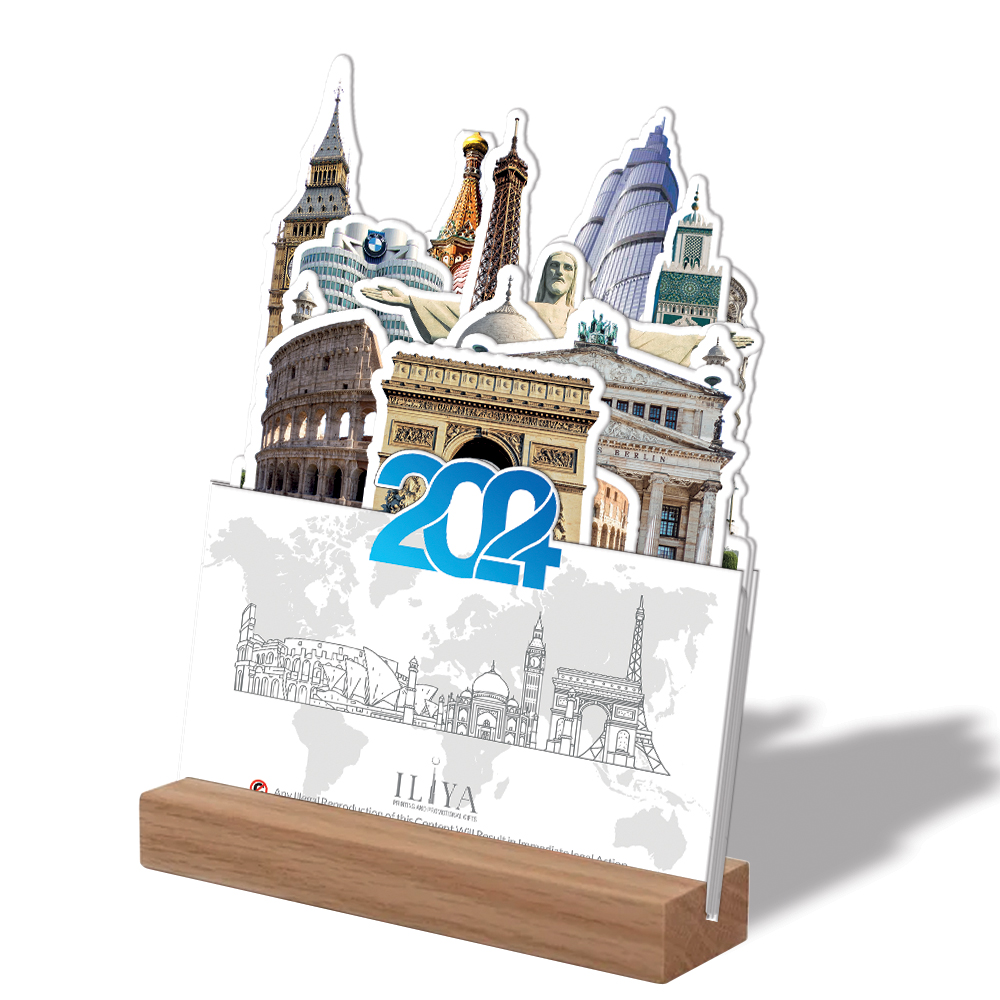Three-Dimensional Calendar Featuring 12 World Landmarks!
Congratulations on creating a three-dimensional calendar with the capability to showcase 12 fascinating global landmarks! What you have in this three-dimensional calendar can be an engaging and informative experience for exploring various wonders of the world. Below are some details and features for your calendar:
Place Names:
- For each month, specify the name of a noteworthy landmark or important place from around the world. This could include cities, historical landmarks, natural beauties, cultural festivals, or anything you find captivating as attractive destinations.
Beautiful Images:
- Choose beautiful and captivating images for each location and display them in the calendar. These images can be related to each landmark and enhance visual appeal.
Historical and Cultural Information:
- Provide a brief description of historical and cultural information for each landmark in a few lines. This information can be intriguing for users interested in history and culture.
Visit Dates:
- For each location, display the visit date or significant events related to it. This information can assist users in choosing an appropriate time to visit those landmarks.
Local Culture:
- In the details for each location, highlight the local culture and important cultural differences of that region.
Links and Communication Methods:
- Add relevant links or useful guides for each location. Additionally, by scanning the barcode on each page, users can experience a virtual journey.
With these features, your calendar can serve as a valuable and interesting source of information for travel enthusiasts and those interested in exploring global landmarks.

The Arc de Triomphe
The Arc de Triomphe is one of the most iconic monuments in Paris, France. In English, "Arc de Triomphe" translates to "Triumphal Arch." This historic arch stands at the western end of the Champs-Élysées and honors those who fought and died for France in the French Revolutionary and Napoleonic Wars.
The construction of the Arc de Triomphe was ordered by Napoleon Bonaparte in 1806 after his victory at Austerlitz in 1805. However, it was not completed until 1836, long after Napoleon's reign. The arch is adorned with various reliefs and sculptures that depict scenes from French military history.
The monument is particularly famous for the Tomb of the Unknown Soldier from World War I, which lies beneath the arch and is commemorated by the Eternal Flame. The Arc de Triomphe also offers a panoramic view of Paris from its terrace.
The arch serves as a symbol of national pride and is a prominent part of French identity. It is a central point for various military parades and national events. The full name of the monument in French is "Arc de Triomphe de l'Étoile," emphasizing its location at the Place de l'Étoile, where twelve grand avenues converge.
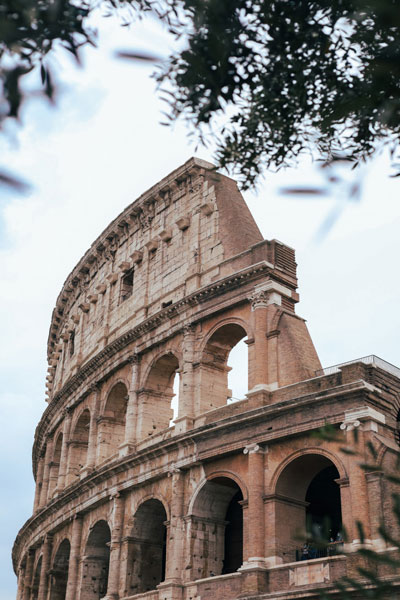
Colosseum
Location: Rome, Italy
Construction Period: AD 72–AD 80 (Vespasian and Titus), further modifications under Domitian (81–96 AD)
Architects: The specific architects are not definitively known, but it is believed that the construction was overseen by various engineers and architects.
Historical Context:
- Built during the height of the Roman Empire, a period known for its architectural and engineering achievements.
Architecture:
- A massive elliptical amphitheater made of concrete and sand.
- Capacity to hold up to 80,000 spectators.
- Features a complex system of tunnels, chambers, and elevators beneath the arena floor.
Use:
- Primarily used for gladiatorial contests.
- Hosted various public spectacles, including animal hunts, mock sea battles, executions, and dramatic performances.

Konzerthaus Berlin
The Konzerthaus Berlin is a renowned concert hall located in the Gendarmenmarkt square in the central Mitte district of Berlin, Germany. Here's an overview:
Construction Period:
- The original construction took place in 1818–1821.
History:
- The Konzerthaus Berlin has a rich history and has played a significant role in Berlin's cultural life.
- It was originally built as the Schauspielhaus (playhouse) and later converted into a concert hall.
- The building has been the venue for various historic events and performances.
Architecture:
- The original design by Karl Friedrich Schinkel reflects neoclassical architectural elements.
- The exterior features a portico with columns and a triangular pediment.
- The interior is designed with a focus on acoustics and has undergone modifications to accommodate modern concert standards.

Taj Mahal
The Taj Mahal is an iconic and globally recognized monument located in Agra, India. Here is an overview:
Architect: The principal architect of the Taj Mahal was Ustad Ahmad Lahori, an architect of Persian descent. It is said that numerous artisans and craftsmen were involved in its construction.
Construction Period:
- Construction began in 1632 during the reign of the Mughal Emperor Shah Jahan.
- The main mausoleum was completed in 1648, while the entire complex was finished around 1653.
Purpose and History:
- The Taj Mahal was commissioned by Emperor Shah Jahan as a mausoleum for his favorite wife, Mumtaz Mahal, who died during childbirth.
- The Taj Mahal is a symbol of enduring love and is considered one of the most beautiful buildings in the world.

Eiffel Tower
The Eiffel Tower is one of the most iconic landmarks in the world, located in Paris, France. Here's an overview:
Architect: The Eiffel Tower was designed by the French engineer Gustave Eiffel and his construction company for the Exposition Universelle (World's Fair) held in Paris in 1889.
Construction Period:
- Construction started in 1887 and was completed in 1889.
Purpose and History:
- The Eiffel Tower was built as the entrance arch to the 1889 Exposition Universelle, which marked the 100th anniversary of the French Revolution.
- Initially, there was some controversy about its design, but it has since become an enduring symbol of France and Paris.
Architecture:
- The tower is made of iron and consists of three levels.
- It stands approximately 324 meters (1,063 feet) tall, making it one of the tallest structures in Paris.
- The lattice design gives it a distinctive and elegant appearance.
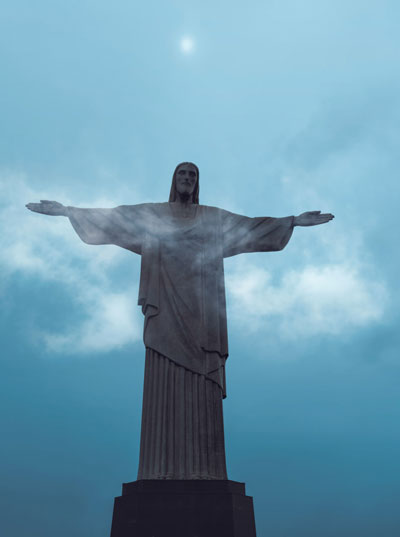
Christ the Redeemer
Christ the Redeemer (Cristo Redentor in Portuguese) is an iconic statue of Jesus Christ located in Rio de Janeiro, Brazil. Here's an overview:
Construction Period:
- Construction began in 1922 and was completed in 1931.
Architects: The statue was designed by Brazilian engineer Heitor da Silva Costa and sculpted by French-Polish artist Paul Landowski. The face was created by Romanian sculptor Gheorghe Leonida.
Purpose and History:
- The statue was built to commemorate the centennial of Brazil's independence from Portugal.
- It also served as a symbol of Brazilian Christianity.
Architecture:
- The statue is made of reinforced concrete and soapstone.
- It stands 30 meters (98 feet) tall, with an additional 8-meter (26-foot) pedestal, making it one of the tallest statues of Jesus in the world.
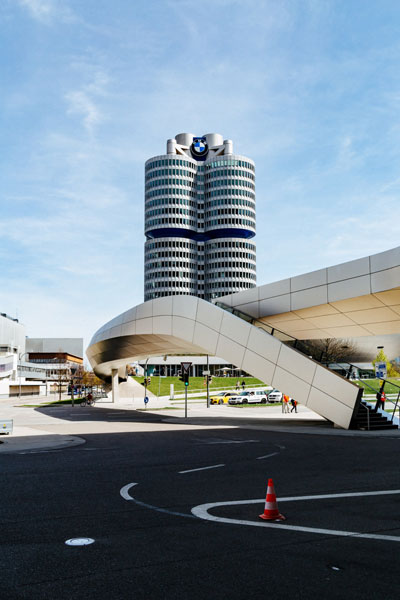
BMW Museum
The BMW Museum is an automobile museum located in Munich, Germany, dedicated to showcasing the history and achievements of the Bavarian Motor Works (BMW) brand. Here's an overview:
Opening Date: The museum officially opened in 1973, and it underwent a major renovation and expansion, reopening in 2008.
Architecture:
- The museum building is an architectural masterpiece, designed by the Austrian architect Karl Schwanzer.
- It features a futuristic design, with a distinctive "double cone" structure.
Purpose:
- The BMW Museum serves as a place to exhibit the history, innovations, and technological advancements of BMW over the years.
- It complements the adjacent BMW Welt, a multi-functional exhibition and delivery center.
Exhibits:
- The museum features a wide range of exhibits, including historic BMW vehicles, motorcycles, and engines.
- Interactive displays and multimedia presentations showcase the evolution of BMW's design, technology, and engineering.
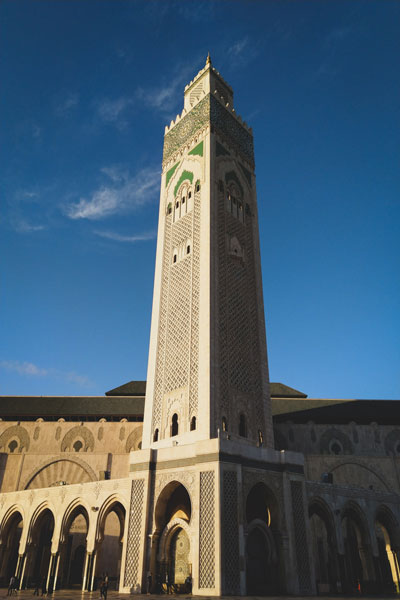
Hassan II Mosque
The Hassan II Mosque (Mosquée Hassan II) is an iconic mosque located in Casablanca, Morocco. Here's an overview:
Year of Construction:
- Construction began in 1986, and the mosque was inaugurated in 1993.
Architect: The architectural design of the mosque was led by the French architect Michel Pinseau.
Architectural Features:
- The Hassan II Mosque is one of the largest mosques in the world and boasts the tallest minaret globally, reaching a height of 210 meters.
- The mosque is built above the Atlantic Ocean, providing a spectacular view from the terrace.
- The prayer hall can accommodate up to 25,000 worshippers.
Technological Innovations:
- The mosque features a retractable roof, allowing the prayer hall to be open to the elements.
- It has a laser lighting system that points toward Mecca at night.
Cultural and Religious Significance:
- The Hassan II Mosque is a significant place of worship and a symbol of Islam in Morocco.
- It pays tribute to King Hassan II, under whose reign the construction began.

Saint Basil's Cathedral
Saint Basil's Cathedral, also known as the Cathedral of Vasily the Blessed, is a world-renowned Russian Orthodox cathedral located on Red Square in Moscow, Russia. Here's an overview:
Year of Construction: The cathedral was built from 1555 to 1561.
Architect: The architect of Saint Basil's Cathedral is believed to be Postnik Yakovlev, although the exact attribution is uncertain.
Architectural Style:
- Saint Basil's Cathedral is an outstanding example of Russian architecture, characterized by colorful onion domes and vibrant patterns.
- It features a unique and distinctive design with multiple chapels arranged around a central core.
Design Features:
- The cathedral consists of nine chapels, each dedicated to a different saint.
- The colorful onion domes are a prominent feature, and each dome is uniquely shaped and painted.
- The exterior walls are adorned with intricate patterns and decorative elements.
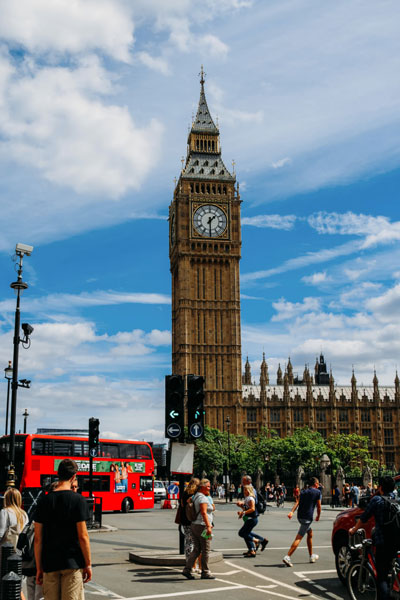
Big Ben
Big Ben is the nickname for the Great Bell of the clock at the north end of the Palace of Westminster in London, United Kingdom. However, the term "Big Ben" is commonly used to refer to both the clock and the clock tower. Here's an overview:
Year of Completion: The clock tower was completed in 1859.
Architect: The clock tower, officially known as the Elizabeth Tower, was designed by architects Charles Barry and Augustus Pugin. The clock and bell were designed by Edmund Beckett Denison.
Features:
- The clock tower stands at the north end of the Palace of Westminster and is an iconic symbol of London.
- The Great Bell, often referred to as Big Ben, is housed within the tower.
- The tower reaches a height of 96 meters (315 feet) and consists of brick and limestone.
Great Bell (Big Ben):
- The Great Bell, commonly known as Big Ben, weighs over 13.5 tons.
- It is renowned for its distinctive deep tone and is one of the largest bells in the United Kingdom.
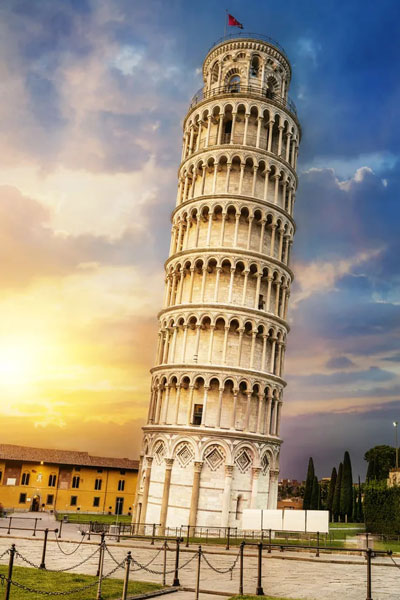
Leaning Tower of Pisa
The Leaning Tower of Pisa (Torre Pendente di Pisa) is one of the most famous and iconic landmarks in the world, known for its distinctive tilt. Here's an overview:
Year of Construction: The construction of the tower began in 1173 and was completed in the mid-14th century.
Architect: Although the identity of the original architect is uncertain, the design is often attributed to Bonanno Pisano.
Architectural Style:
- The Leaning Tower of Pisa is a freestanding bell tower, part of the cathedral complex in Piazza dei Miracoli.
- It features Romanesque and Gothic architectural styles.
Design Features:
- The tower is cylindrical and has eight stories.
- It stands approximately 56 meters (183 feet) tall.
- The most distinctive feature is its noticeable lean, caused by subsidence of the foundation.

Burj Khalifa
The Burj Khalifa is an iconic skyscraper located in Dubai, United Arab Emirates. Here's an overview:
Year of Completion: The Burj Khalifa was officially opened on January 4, 2010.
Architect: The architectural design of the Burj Khalifa is by the firm Skidmore, Owings & Merrill, and the chief architect was Adrian Smith.
Construction Period:
- Construction began in 2004 and was completed in 2010.
Height:
- The Burj Khalifa is currently the tallest building in the world, standing at a height of 828 meters (2,717 feet).
Architectural Style:
- The design of the Burj Khalifa is influenced by a combination of Islamic and contemporary architectural styles.
- The Y-shaped floor plan is designed to maximize views of the surrounding area.
Features:
- The skyscraper has a total of 163 floors and features both residential and commercial spaces.
- It has several observation decks that offer panoramic views of Dubai.



